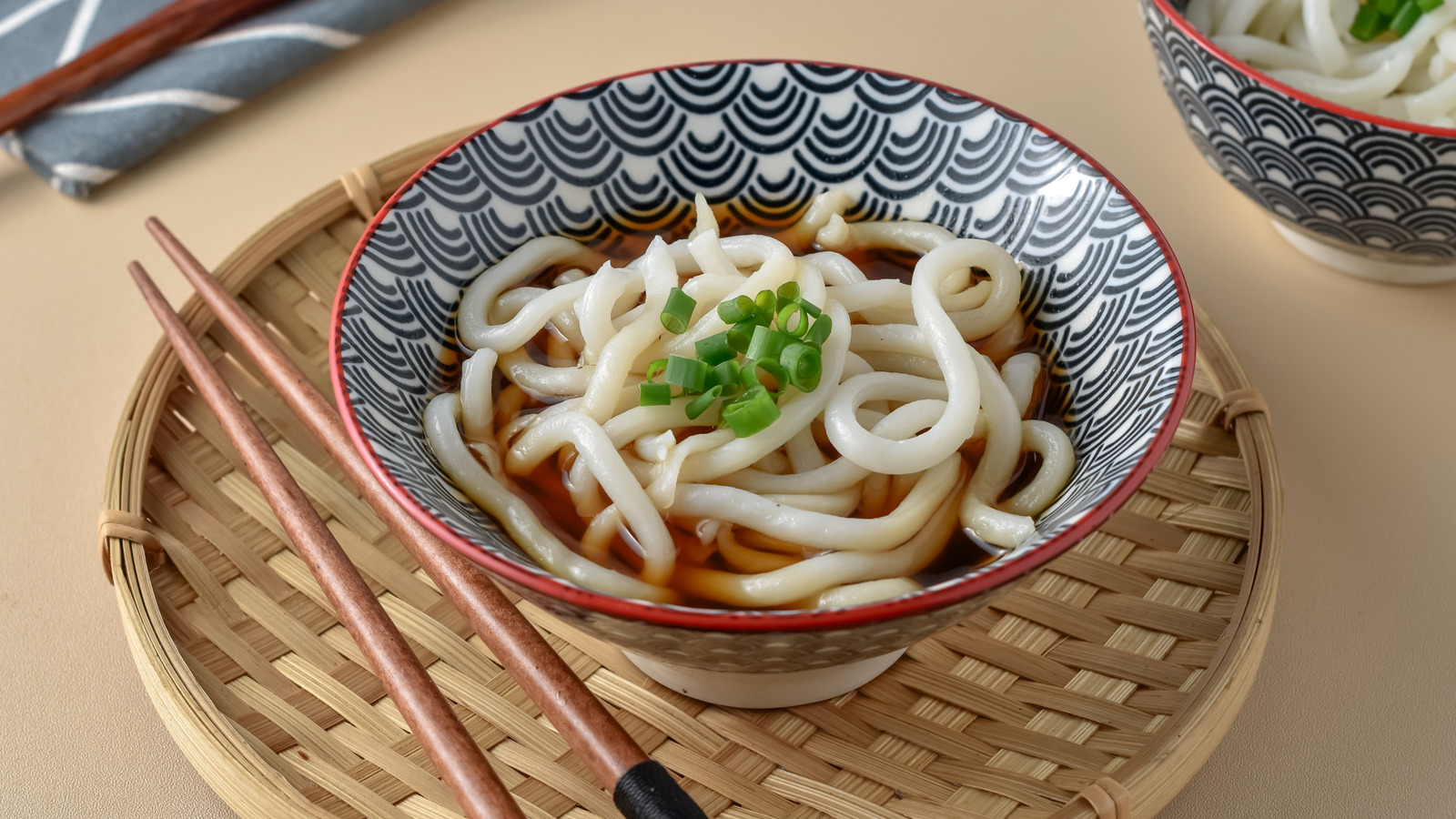
With the growing global popularity of Japanese cuisine over the past few decades, dishes like sushi, sashimi, ramen, and udon noodles have become culinary staples. Although udon noodles gained popularity a little after ramen and sushi, noodle enthusiasts and foodies worldwide have come to love them due to their chewy, bouncy texture. Moreover, since udon noodles have a fairly subtle flavor, they easily soak up the flavors of any broth or sauce that they're served with, which makes them versatile and even more appreciated.
Considering how popular they are, it's no surprise that a lot of home cooks have made endless attempts to prepare a perfect bowl of udon noodles. If you're one of them, you may have noticed that despite how hard you try, there's always something amiss, and somehow, your bowl of udon noodles has probably never tasted quite as good as what you'd get at a Japanese restaurant. Well, truth be told, udon noodles do taste better at restaurants, and there's a variety of reasons for this.

Similar to how other Japanese staples like ramen always taste better at restaurants , thanks to factors like using authentic ingredients and the right techniques, udon noodles also need some extra attention and tender loving care for them to turn out perfect. But luckily, once you've read this article, you will easily be able to make a piping hot bowl of chewy udon noodles that taste just as great as the ones from your favorite restaurant. Restaurant chefs make their noodles from scratch Since restaurants make their noodles from scratch, their final dish has an edge over homemade versions.
It's a fact in the culinary world that fresh is always better than frozen or dried food, and udon noodles are no exception to this rule. Freshly made noodles have a striking aroma and texture, and they also cook a lot better than their frozen and dried counterparts. Frozen udon noodles are still a much closer substitute to fresh ones, as they're usually flash-frozen immediately after being made.
Dried udon noodles, however, tend to have less of that quintessential chewy texture and can instead resemble the texture of regular wheat noodles. This happens because of the drying process removing their moisture, which can change the texture of the udon noodles, even after they're cooked properly. Moreover, since it takes longer to rehydrate and cook dried udon noodles, it's also very easy to overcook them and turn them mushy.
What this means is, if you want to make udon noodles that taste just as great as those from a restaurant, it's best to steer clear of dried noodles. Frozen udon noodles are still pretty good, but for a true restaurant-style finish, you can easily try making udon noodles at home. It's a fun experience to make them from scratch, and the best part is, they can be made with just a few pantry-staple ingredients.
Also remember to step on the dough (yes, literally!) for the chewiest udon noodles . They use authentic ingredients Restaurants have to maintain high standards, so naturally, they use authentic ingredients to make just about everything, including udon noodles. Technically, udon noodles are made with just three ingredients: Flour, water, and salt.
Although regular all-purpose flour works fine and is used by many noodle enthusiasts, most restaurants instead use chūrikiko, which is a Japanese version of all-purpose flour. This flour has a medium gluten content of 8-11%, which is ideal for udon noodles. Using a type of flour with the right gluten content is crucial for udon noodles, as that's what gives them their bouncy texture.
The regular all-purpose flour that's commonly used in Western countries can have a higher gluten content of up to 10-13%. Although their gluten contents are similar, the slightly larger amount in this all-purpose flour can create a subtle difference in the texture of udon noodles. Udon noodles made with regular all-purpose flour, if made the right way, will be sufficiently chewy and bouncy, but making them with chūrikiko definitely gives more authentic results.
In Japan, it's used to make udon noodles and street foods like takoyaki and okonomiyaki . To make your homemade udon noodles taste as delicious as what you'd get from a restaurant, using authentic ingredients like Japanese chūrikiko is highly recommended. Chefs rest the noodle dough for a long time Udon noodle dough needs to rest for a sufficient amount of time for the noodles to get the right texture.
Restaurants make large batches of dough every single day so that they can let each batch rest for prolonged periods (sometimes even overnight), while also having enough dough ready for orders. On the other hand, home cooks usually make just a single batch, and letting it rest for a long time can be frustrating. Many home cooks decide to shorten the resting period, which creates a massive difference between homemade udon noodles and those from a restaurant.
Udon noodle dough generally needs to be rested for specific amounts of time at various stages in the dough-making process, which comes to an overall resting time of at least two hours. Similar to how it can be disastrous if you don't let pasta dough rest , not resting udon noodle dough can lead to the noodles having a poor texture. This is because resting allows the water in the dough to distribute more evenly, which gives a more uniform texture and makes it easier to cut the noodles.
Moreover, when udon noodle dough is mixed, the gluten strands contract, which also toughens the dough up. Letting the dough rest initially, between each kneading cycle, and at the end helps the gluten strands relax. The result is a more pliable dough and noodles with a fantastic chewy texture, like the ones you enjoy at a restaurant.
They use the right type of water to make the noodles Although you may think that any type of water will work for making udon noodles from scratch, that isn't really the case. Using the right type of water is crucial and also an underrated way to get the right texture. Since most professional chefs are aware of this, they're always vigilant about the type of water they use, which makes the udon noodles from a restaurant taste far better.
It may seem a bit confusing to talk about the "right type of water," so let's first discuss that. There are two types of water: Hard and soft. Hard water tends to have a higher mineral content, with dissolved calcium and magnesium, while this is a lot lower in soft water.
Soft water, with fewer minerals, means softer dough, making it easier to stretch it out and cut into even-sized, uniform noodles. On the other hand, using hard water toughens up the dough due to its high mineral content. This makes it extremely challenging to stretch the dough, and may also result in cracks on the surface — and possibly cracked and broken noodles when you try to cut the dough.
In Japan, tap water is generally used to make udon noodles, as it's usually soft. Sadly though, most of the tap water in the U.S.
is hard water, so if you want to make good quality udon noodles at home, it is better to filter your water to soften it. Restaurants serve the noodles with a freshly made broth One of the most common ways to enjoy udon noodles is with a broth, and to keep the quality of their udon noodles as high as possible, restaurant chefs always serve them with a freshly made one. Kake udon, or udon noodle soup depends highly on the flavor of the broth that it's served with, considering the fact that udon noodles don't have a flavor of their own.
The broth used in kake udon is known as kakejiru and is made with dashi, soy sauce, and mirin. Dashi is a distinctive type of Japanese stock that's used as a base for many recipes, and is what gives kakejiru its distinctive flavor. It's usually made with dried kelp and katsuobushi (shavings of dried, fermented, and smoked skipjack tuna) and has a fantastic umami-rich flavor which makes it pretty unique.
However, many home cooks prefer making their broth with instant dashi powder instead, as it's a lot more convenient. Although it can work as a quick fix, instant dashi powder is nothing like freshly made dashi, which has a much stronger umami flavor from its high-quality ingredients. Instant dashi powder, on the other hand, may lose much of its natural umami flavor due to dehydration, resulting in a broth that isn't as flavorful.
Luckily, making fresh dashi is a lot easier and quicker than it may seem, for a better-tasting kake udon. Chefs know the right noodle to broth ratio Technically, there are no set rules for the amount of broth you can top your noodles with when making kake udon. However, too much or too little broth can still make or break the dish, and professional chefs are well aware of this.
Considering that, they always know the right amount of broth to add to udon noodles, which makes the udon noodle soup from a restaurant taste consistently better than a homemade version. The flavor of kake udon comes from the broth, but using too much broth can overpower the subtle flavor of the noodles. A large amount of broth can sometimes also compromise the chewy texture of the noodles — it's more likely for them to sit around in the hot broth for longer, since you may take more time to get to the noodles.
The heat can make the udon noodles mushy and unpleasant to eat. On the flip side, using too little broth can result in a dry udon noodle soup, with barely any flavor. So, although it may not seem too important, getting the noodle-to-broth ratio right is indeed important, to give your udon noodle soup a restaurant-like flavor and finish.
An easy way to get the ratio right is to start with the same amount of broth as noodles, and gradually increase the quantity if you prefer. Chefs use the right equipment for stir-frying udon noodles Besides kake udon, a popular way to enjoy udon noodles is by stir-frying them. Known as yaki udon in Japan, this dish consists of fresh udon noodles, vegetables, some protein, and a variety of sauces.
Many chefs stir-fry their yaki udon in a wok, which helps with cooking the vegetables and protein to the right texture, and also ensures a uniform coating of sauce on the udon noodles. Woks are specifically designed to endure high heat and cook stir-fried dishes evenly for them to taste as delicious as they do. Of course, not all home cooks will have a wok at home, so they instead use whatever they have to hand.
Although it is possible to stir-fry udon noodles in any sort of pan, the results may not be the same as those from a restaurant. Other than being able to endure high heat, woks also help with better stir-frying as they have a rounder base compared to most other types of pans, which helps with better heat distribution in the center. The round base also makes it a lot easier to move ingredients around.
Some home cooks do have a wok at home, but using a wok correctly also takes skill and practice. Woks are heavy and not so easy to move around, although it may look easy, seeing how effortlessly chefs do it. Plus, there are a few common mistakes with a wok that novice cooks often make, which can also make their yaki udon not turn out as great as professionally made noodles.
Restaurants serve noodles topped with flavor enhancing ingredients High-end restaurants are known for using the best ingredients, even when it comes to garnishes, so most restaurants that serve authentic udon noodles follow the same principle, and top their udon noodles with carefully chosen ingredients to complement the flavors in the dish. Certain ingredients help enhance the natural umami flavor of the broth in an udon noodle soup, or the sauces added to stir-fried udon noodles, giving restaurant noodles a fuller flavor. Since standard garnishes used for udon noodles, like spring onions and soft-boiled eggs, are easy to come by, many home cooks stick to them and barely ever experiment with other toppings.
While these additions also mildly enhance the flavor of udon noodles, there are a few excellent alternatives available. Yuzu kosho is a Japanese condiment made with yuzu (a fragrant East Asian citrus fruit with a tart flavor) with fermented hot chile peppers, and salt. This condiment has the right amount of heat with a balanced tart flavor, that really helps the umami-rich flavor of the broth to shine.
Another option is bonito flakes, which are made from smoked, fermented, and dried skipjack tuna. Bonito flakes are an expert-recommended ingredient for Japanese cuisine more generally, with an intense umami flavor of their own that further enhances the flavor of the broth. The good news is that both of these ingredients are easily available at Japanese grocery stores, and are worth stocking up on, to give your homemade udon noodles a restaurant-like flavor.
Restaurants are experienced at cooking the noodles perfectly Since professional chefs have years of experience backing them up, they know how to cook udon noodles perfectly. Generally, fresh udon noodles need about 10 minutes to cook, varying a bit depending on their thickness. However, the experience of cooking udon noodles every single day gives chefs an innate instinct about exactly when they should be strained, by simply observing them.
This leads to the noodles always having the right texture, and eventually tasting a lot better than homemade udon noodles. This may seem a bit exaggerated, because honestly, how hard can it be to boil noodles in water? But it really isn't, as plenty of small mishaps can happen while cooking udon noodles. Plus, factors like the water's temperature, and sometimes even the size of the pot used, can have an effect on how the noodles turn out once they're cooked.
Professional chefs are aware of these factors, so they make sure to get everything right, to cook their noodles perfectly. Moreover, other than the cooking process itself, chefs also know exactly when and how long to rinse udon noodles once they are ready, to prevent them from overcooking. This also gives the udon noodles made at a restaurant an edge.
Since most home cooks probably don't make udon noodles every single day, it's a lot easier to inadvertently mess up one of these contributing factors, ending up with their noodles having a sub-standard texture. Other than taking care to follow the recipe closely, the only way to gain more experience is with practice. Luckily, that means enjoying homemade noodles more often.
.















